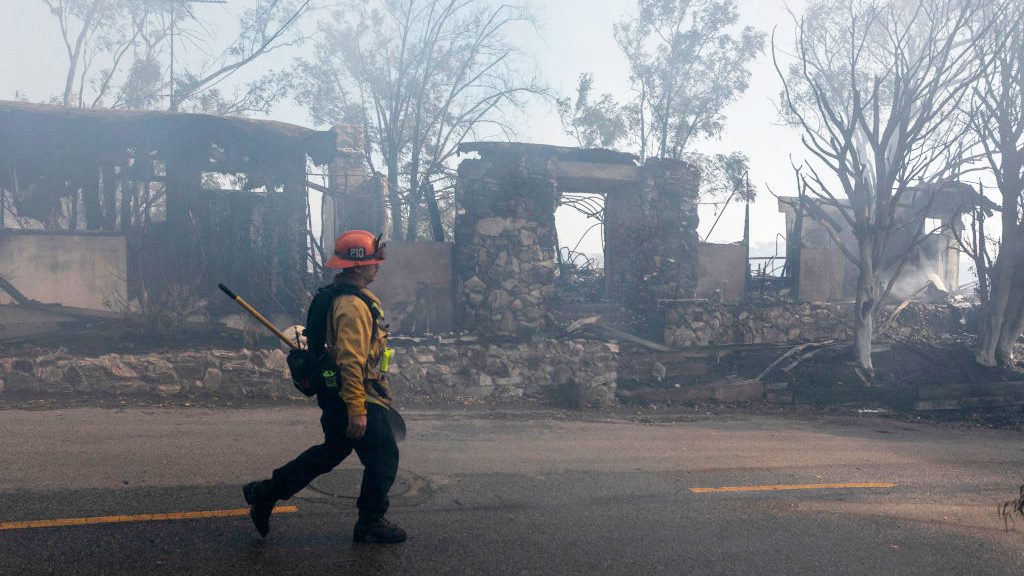
David McNew/Getty Images
It’s wildfire season again in California, and with blazes burning across the state and thousands of homes at risk, the governor has declared a state of emergency. Hundreds of thousands of people have been forced to evacuate, and if a significant number of them can’t go back, the state’s housing shortage will likely make a bad situation even worse.
Gov. Gavin Newsom declared a statewide emergency late last week. Currently, roughly 34,000 firefighters are battling multiple blazes, including the Kincade fire in Northern California’s wine country, the Tick fire north of Los Angeles, and the recently ignited Getty fire in northwestern L.A. Millions have had their power cut off by the state’s struggling power utility, which has been blamed for sparking previous blazes. This all comes just a year after the deadliest, most destructive wildfire season in the state’s history.
The Kincade fire has led to nearly 200,000 evacuations and the destruction of 40 homes in Sonoma County, the same area that was devastated by fires in fall 2017. The 5-day-old fire consumed more than 66,200 acres on its way to Santa Rosa as of Monday morning. So far, no casualties have been reported.
But an additional 70,400 homes in the area are at risk, according to the California Department of Forestry and Fire Protection. And if a significant number of those houses are destroyed or become uninhabitable, there likely won’t be enough housing for everyone in need of it—and home and rental prices, already high, will probably get pushed up even more.
The homes in the evacuation zone are worth a median $603,308—that adds up to about $33.7 billion collectively, according a recent realtor.com® analysis. Nearly three-quarters of the homes are single-family abodes.
The fire “certainly has the potential to reach a lot of houses if the wind continues to push it,” says Tom Jeffery, senior hazard scientist at real estate data firm CoreLogic. He explains that the area’s dry vegetation, which serves as fuel for the blaze, and strong winds make a dangerous combination. “The wind moves the fire faster, and it actually creates a more intense, hotter fire.”
Meanwhile, the Getty fire in Los Angeles, which erupted early Monday morning, is causing firefighters headaches as it’s in a far more populated area that includes such wealthy neighborhoods as Brentwood and Pacific Palisades. More than 13,000 homes, about 77% of which are single-family residences, are in the evacuation zone. They have a median value of more than $2.4 million each, or $27.8 billion collectively.
Just five homes had been damaged as of Monday morning as the blaze tore through more than 500 acres, according to the Los Angeles Fire Department. But more than 100,000 residential and commercial buildings were at risk from the brush fire in the mandatory evacuation zone.
This being Los Angeles, evacuees include such big names as basketball player LeBron James, who owns two homes in Brentwood, and former California Gov. Arnold Schwarzenegger.
“Man these LA [fires] aren’t no joke,” James wrote on Twitter. “Had to emergency evacuate my house and I’ve been driving around with my family trying to get rooms. No luck so far!” He did eventually find a place to stay.
Schwarzenegger also tweeted that he had safely evacuated.
In California, about 2,019,800 properties are at high to extreme risk of damage from wildfires this year, according to Verisk’s 2019 wildfire analysis. That was nearly three times as many as in the next at-risk state of Texas, where 717,800 properties were at the same risk levels, and Colorado, where there were 371,100 properties in danger.
How much do local home prices fall—and rise—after a wildfire?
Any homes that are damaged or destroyed by the fires will obviously lose significant value. But residences that survive the disasters unscathed in badly hit areas often sell for discounts of 10% to 25% for a few years, says real estate appraiser Orell Anderson of Strategic Property Analytics.
“If you’re the last house standing on the block, that’s the worst,” says Anderson, who specializes in properties damaged by crimes or natural disasters. That’s because few want to live in ugly, burned-out areas.
Plus, these areas can become more susceptible to landslides when it rains, without the roots of vegetation to keep the soil in place, he warns.
Discounts are more pronounced in areas that suffer repeated natural disasters. This could affect Sonoma County, which was one of the three counties affected by the Tubbs fire in 2017. The blaze killed at least 22 people and caused more than $1.2 billion in damages in Sonoma, Napa, and Lake Counties, according to the Washington Post.
That also takes a psychological toll, which can both motivate people to leave and discourage people from moving in.
“In the Santa Rosa area, you’ve had people who’ve just rebuilt and now they’re being evacuated again,” says CoreLogic’s Jeffery. “I don’t know how terrifying that must be for the residents.”
Just outside the fire-affected area, however, home and rental prices typically surge as hordes of displaced residents compete for a very limited supply of housing, says Anderson. That can push prices up 5% to 15%, although he’s seen them spike by as much as 50% in a few cases.
“We’ve been through these difficult times before. … [And] we have a very resilient community,” says real estate agent Daphne Peterson of Keller Williams Realty in Santa Rosa. Real estate sales have been at a standstill since the fire erupted. “The big wild card will be if people feel trauma and don’t want to be in an area where there are wildfires.”
The post California’s Wildfires Put Tens of Thousands of Homes at Risk Amid a Housing Shortage appeared first on Real Estate News & Insights | realtor.com®.
source https://www.realtor.com/news/trends/californias-wildfires-put-tens-of-thousands-of-homes-at-risk-amid-a-housing-shortage/
No comments:
Post a Comment